#chromatic habitat
Text
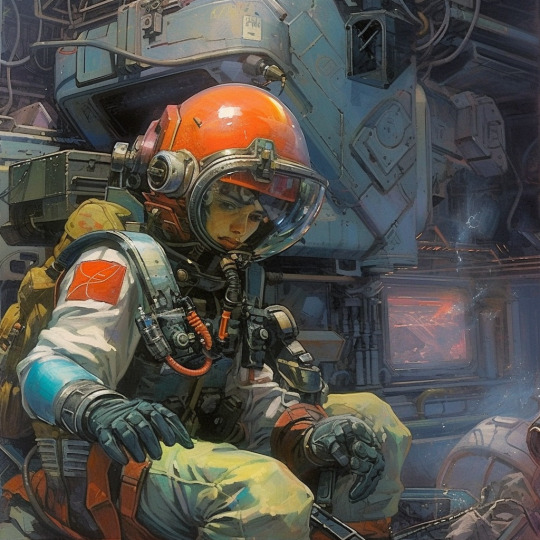
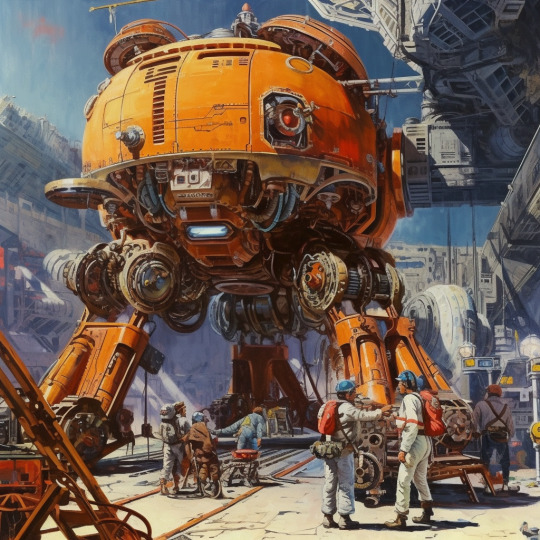

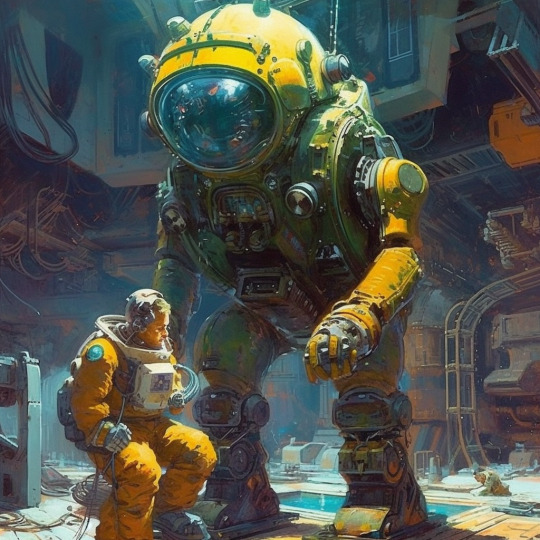


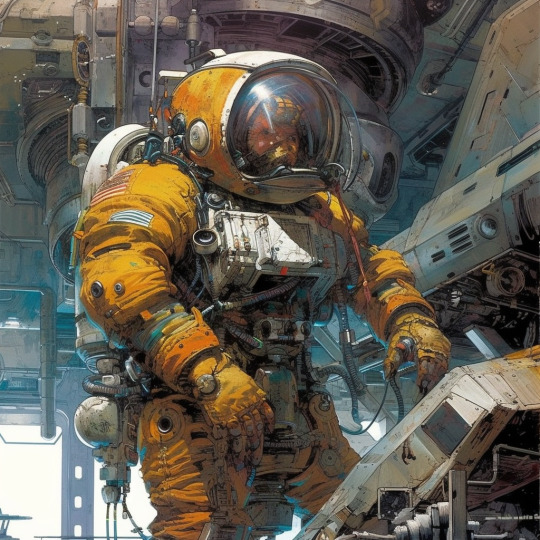



By Sandu
Prompt:
Around a emotional military construction massive robot gorgeous Aliens movie mecha, astoning pulp art chromatic balance frank frazetta translucent UFO engine, mechanical complexity, miner with giant astro robot front view examining the strange rocket engines, close up, helmet and gloves off on the side, tattoos on hands and face, punk style, happy, habitat in space, medical space station giant module, engine toroidal, massive, close up street view going to the sky, impressionism oil painting, armored spaceship, eerie Sandu Baciu style, mid day god rays, steven holl, detail textured, rectangular fields, extreme angle, pastel volumetric light at dawn, octane render, packed with hidden details
#nestedneons#cyberpunk#cyberpunk art#cyberpunk aesthetic#cyberpunk artist#art#cyberwave#astropunk#retro#line art#inspi#cyberpunk inspiration#cyberpunk illustration#scifi#retroscifi#retrowave#scifi art#retro scifi#scifi aesthetic#scifi illustration#scifi geek#thisisaiart#midjourney#ai artwork#ai art#ai artist#aiartcommunity#prompt sharing#promptsharing
184 notes
·
View notes
Text
Today we are talking about orbulon's eyeballs
A question that nobody cares about is what is orbulon's color vision like? He is obviously adapted for low light conditions (white/translucent color, can't function without completely opaque sunglasses) so he wouldnt really need to see most of the colors that terrestrial earth creatures can. We know for a fact that he can see red because he has a microgame in diy that has you select a red vs. white shape. This is interesting to me because on earth deep sea creatures, if they have any color vision at all, tend to be more sensitive to blue light because red light doesn't reach deep ocean depths. (Comparing him to benthic animals and not cave animals because most animals in dark cave habitats are blind and we know he's not.) In fact red color vision is comparatively rare in the animal kingdom. Here are some spitball reasons why animals might want to see red
Seeing when fruit is ripe (e.g. primates)
Pollination (e.g. hummingbirds)
Predation (e.g. snakes, mosquitos*)
Orbulon to me is not a pollinator. Nor is he a fruit guy. To me a squishy smart invertebrate that eats hamburgers is a predator.
*HERES THE THING THOUGH. i mentioned that snakes and mosquitos can see red but i lied. Snakes' actual eyes can only see blue and green shades, and very poorly, but snakes with heat pits can detect infrared thermal radiation from their prey. Likewise, mosquitos have dogshit vision but when they are presented with olfactory stimuli from their prey, namely carbon dioxide from stank breath, they are able to detect and show a preference for certain warm colors like red and orange. We all know orbulon's eyesight to be quite dogshit. However, like the snake, and like the mosquito, orbulon does have a far more competent sensory organ to augment his dogshit eyes
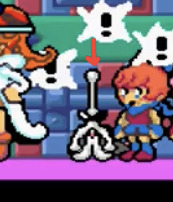
Thats right. The schlorb
now the idea of orbulon's species having infrared/red color "vision" to detect prey is very tempting, but that also hinges on the assumption that his prey (or the prey of his ancestors) would be warm blooded. But thats crazy
so Instead im going to posit that maybe he doesnt need the Schlorb for colors at all. What if his eyes are a different kind of fucked up.
i alluded to orbulon being like a cephalopod earlier. Something you might know about the stars of the cephalopod world (cuttlefish and to a lesser extent octopodes) is the fact that they can change their color extremely well to camouflage. What if i told you they cant actually see color. Ok sit with that for a sec. now what if i told you that they actually can see color.
I didnt lie to you im just being needlessly obtuse. Cuttlefish eyes only have one photoreceptor type, and so their "color vision" is likely monochramatic. How Ever. Light bends differently underwater. Each color has its own wavelength, and if a lens is not able to "focus" on every color equally it creates chromatic distortion, which causes some colors to be blurrier or more in focus than others. Even though the cuttlefish can't "see" these colors the same way we do, its eyes can differentiate these different wavelengths based on their distortion bu rapidly focusing and unfocusing its eyes at different depths. Let's take a look at cuttlefish eyes

The cuttlefish has weirdly curved eyes, which can change to a W-shape in higher light conditions and become more ovular in low-light conditions. It's hypothesized that the curvature of the cuttlefish eye causes chromatic aberration to become more extreme, thus aiding in their detection of different light wavelengths. You know who else has curved fucked up eyes

Ya huh
IN CONCLUSION:
Nothing we know about orbulons color vision has changed because he is a cartoon character and i am insane.
THE END
9 notes
·
View notes
Text
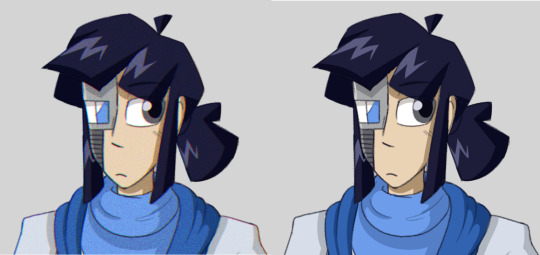
always make sure to crunch your cyborgs in noise filters and chromatic aberration its enriching. slightly blurry partially-degraded collectors box set dvds that have 15 scratches are a delta's natural habitat
(version with effects on the left, without on the right!)
#wip#Genre Mystery#Pale Machine | Delta Laplace#rip xir onto your harddrive and let xir take a holiday in ur file folders
5 notes
·
View notes
Text

name: TempOSt
race: Warforged
class: Sorcerer (Storm)
characterisation: While designed to be the ultimate weapon to turn the tide of a war, their creation was plagued with problems from its start. From miscommunications, to attacks on the base, to straight-up sabotage - it was increasingly clear the weapon wouldn't be finished in time, and so the project was abandoned, and soon after the base was destroyed as the war raged on.
Many years passed, the war ended, adventurers returned to their natural habitat, and some happened to come across the ruined base one day. Through some fate - or luck - the party happened to activate the weapon, which... awoke? They were awake? But what was their purpose? To the party's initial alarm, the weapon looked to them as their creator; in order that they not become a menace they were taken in, but over time the party and the weapon gained affection for each other.
It was not to last. A raider ambush attacked the party, intending to steal and sell the weapon for scrap. As the fight raged on, in a mode of panic, the weapon charged up, and brought a storm down upon the raiders... clipping themselves and some of the party, too. While the surviving raiders fled, the weapon patched up the wounds of their friends, wrote a clumsy 'SORRY', and struck out on their own, looking for a reason for their existence...
-
inspiration: The Defect (Slay the Spire)
been playing a lot of this lately, though heavily modded. ironically Defect is my worst vanilla character but also my favourite design...
anyway. warforged is a clear choice; storm sorcerer too, because in my experience vanilla Defect tends to go for elec orbs (especially since starting with one), and storm sorc can still utilise some things that'd work well for frost/dark orbs, such as mage armor or shadow blade. and, well - chromatic orb exists. honestly even with all the new orbs mods add I generally go for either elec or builds that just get me random orbs...
-
share link: https://www.heroforge.com/load_config%3D32911849/
#dnd#heroforge#the defect#slay the spire#sts#srd builds#honestly all the vanilla character designs are cool though#also one of my mods changed ironclad's name#to ironchad#and I don't know which one it was#I should make the others at some point too
26 notes
·
View notes
Text
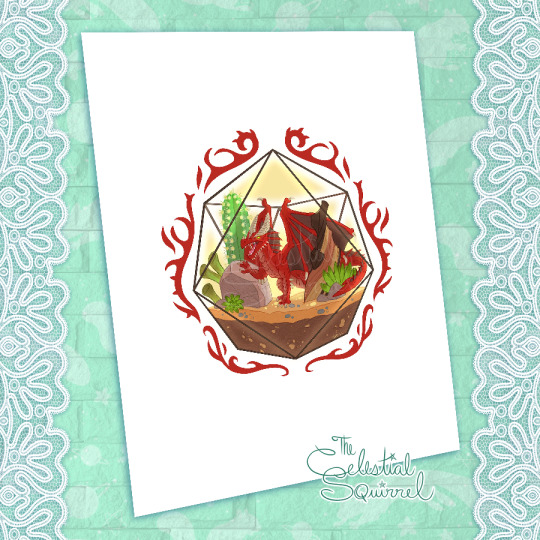


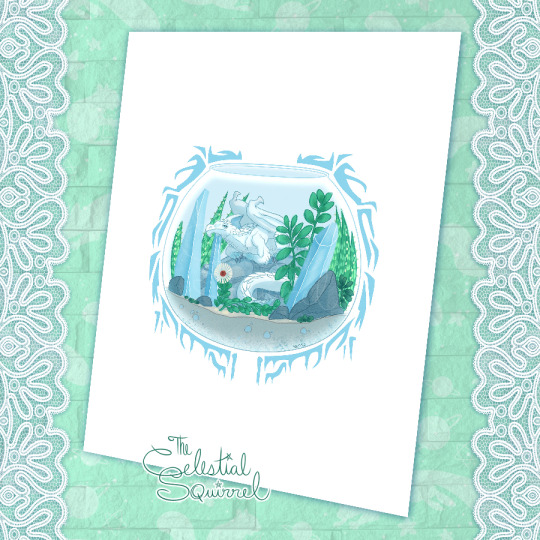
Meet the Terrarium Dragons! Available as 11x17 and 6x8 prints, red, green, black, and white--these chromatic dragons are very particular about their favourite habitats. 🐉🌱🌵🐲
#etsy#etsyshop#artists on etsy#etsycanada#etsystore#dragons#dnd#dungeons and dragons#terrarium#plants#artwork#art print#celestialsquirrel
4 notes
·
View notes
Text
Olympus M.Zuiko 300mm f/4 IS PRO Lens: A Compact Marvel for Telephoto Excellence
The Olympus 300MM F4 PRO stands as a testament to Olympus's commitment to innovation in the micro four-thirds format. This telephoto lens, with its stellar optics and compact design, has become a favorite among photographers seeking high-quality, long-reach capabilities without compromising on portability.
At the core of the M.Zuiko 300mm f/4 IS PRO is its impeccable optical performance. The lens features a sophisticated arrangement of 17 elements in 10 groups, including three Super ED (Extra-low Dispersion) lenses, effectively minimizing chromatic aberrations and ensuring exceptional image sharpness. This optical prowess makes it a go-to choice for wildlife photographers, sports enthusiasts, and anyone in need of a reliable telephoto option.
One of the standout features of UK Camera Club lens is its bright f/4 aperture, allowing photographers to achieve stunning background blur and maintain image clarity even in challenging lighting conditions. The wide aperture also makes it versatile for various photographic genres, including portrait and nature photography.
The inclusion of in-lens image stabilization is a game-changer, especially when shooting handheld at extended focal lengths. Olympus's Sync IS technology combines the lens's stabilization with compatible camera body stabilization, providing an impressive 6 stops of compensation. This is particularly beneficial for photographers on the move, capturing dynamic subjects without the burden of a tripod.
Designed with professional durability in mind, the Olympus Camera features a robust, weather-sealed construction. This ensures the lens can withstand the rigors of outdoor shooting, making it a reliable companion in diverse environments.
In terms of handling, the lens boasts a thoughtful design with customizable function buttons and a manual focus clutch for quick adjustments. The compact and lightweight form factor of the lens enhances its appeal, offering photographers a portable solution without compromising on image quality.
In conclusion, the Olympus 300MM F4 PRO lens stands as a remarkable achievement in the micro four-thirds realm, delivering exceptional telephoto performance in a compact package. Whether capturing wildlife in its natural habitat or freezing fast-paced sports action, this lens continues to impress with its optical prowess and versatility.
0 notes
Text
Evolution of Human Form (2100)
Elasticity and Shape-shifting: Humans have evolved the ability to manipulate their physical forms at will. They can stretch, contort, and morph their bodies into different shapes and sizes, allowing for extreme flexibility and adaptability to various environments.
Bio-luminescence and Chromatic Adaptations: Humans possess the ability to emit bioluminescent patterns on their skin, enabling them to communicate, camouflage, or express emotions through radiant light displays. Additionally, they can change skin pigmentation like chameleons, adapting to surroundings or displaying vibrant, ever-changing colors.
Telepathic Networks and Hive Minds: Through neural enhancements and interconnected brain networks, humans have developed the ability for telepathic communication. Groups of individuals can form temporary hive minds, sharing thoughts, emotions, and skills instantaneously for collaborative problem-solving or creative endeavors.
Aerial Adaptations: Some humans have evolved wing-like appendages or bio-engineered propulsors, enabling limited flight capabilities. These individuals soar through the skies, navigating urban landscapes or accessing elevated habitats.
Photovoltaic Integration: Humans can now harness solar energy through skin adaptations, converting sunlight into usable energy. This ability reduces the need for conventional eating and sustains them through photosynthesis to a certain extent.
Quantum Entanglement Sensitivity: A select few have developed an innate sensitivity to quantum entanglement, allowing them to perceive and interact with quantum phenomena. They might navigate through quantum realms or manipulate quantum states with their consciousness.
Organic Adaptation to Extreme Environments: Humans living in harsh environments like extreme cold, high-pressure depths, or radiation-rich areas have undergone biological alterations. They possess specialized organs or symbiotic organisms that protect them from these extreme conditions.
Retro Evolutionary Traits: In a nod to the past, some humans have evolved to express traits reminiscent of ancient hominids or animal ancestors. These traits could include fur, tails, enhanced olfactory senses, or even adaptations for underwater living.
Temporal Awareness and Manipulation: A select few have unlocked the ability to perceive and manipulate time to a limited extent. They might experience time differently, foresee events, or momentarily alter the progression of time in their immediate vicinity.
1 note
·
View note
Text
The spring-summer 2022 trends make it clear that the year is not a clean slate in stylistic terms. Although there are brands and designers who have seen in this part of the pandemic an opportunity for reinvention, others have chosen to continue within the wheel of Fashion Weeks. From the garments that are going to be worn the most, going through the most seen prints (with the stripes at the top) and the colors that will color the season, we break down some of the main trends.

Neon Green
Not only the classics live high temperatures: each of the last summers have reaffirmed that, indeed, there is no year without fluorine tones not slipping in among the color trends of the season. They are usually a chromatic triad made up of pink, orange and green. However, in 2022 there is only one protagonist in the reign of neons: it is green in its most acidic versions such as lime, which goes on to dye a good thickness of the spring-summer 2022 collections. Versace makes this clear when it bets for total looks in which even footwear and glasses are declined in this pigment. The same idea from which Blumarine starts, but in a two-mile key. Brands also demonstrate that neon green can be an elegant option in dresses, such as Valentino's pleats, Badgley Mischka's dropped shoulders or Naem Khaan's cut-out volumes.
Sparkles
In a way, we are facing a season not suitable for the timid. It is not only dictated by the colors that are in trend this spring summer 2022, but also by the materials that the firms have used the most on the catwalk. Beyond linen or cotton, these holidays are a unique opportunity to shine with their own light, and never better said, because sequins stand out as other protagonists of the moment. Tom Ford applies them to all his color block looks, from tops to bloomers, although it is especially refreshing to go for green blouses like the one worn by Gigi Hadid. However, the dress is still the most common habitat in which to find paillettes: their sparkles make Michael Kors silver a common range, while red and copper tones have also made an appearance among proposals such as those of Loewe, Valentino or Rodarte.
Pink
It happens to all of us: we love to recycle basics. Investing in a garment in a flattering color that continues to be in vogue season after season is a stylistic gesture that is repeated when we talk about the range of pinks. The good thing about the spring summer 2022 trends is that they continue to be worn in all their possibilities: we can mention the fuchsia dresses by Molly Goddard or the very light pink outfits by Sandy Liang. However, the trend also involves combining various saturations of pink: this is what Carolina Herrera does in majestic dresses with trains, Rodarte in pastel pink layered designs or David Koma, in styles that combine a whole variant, from shocking pink to bubblegum pink.
see through
What would a summer season be without fabrics that reveal the body, whatever they are? As with white or with flowers, the association of transparencies with good weather and the exposure of the body is direct and well-known, which is perhaps why the designers have wanted to influence it (what has been said: to go through common territories and acquaintances who provide security and well-being). In fact, precisely with flowers it is mixed in the dresses of JW Anderson and Valentino, as well as in the long skirt of Giambattista Valli, making the delicacy of both elements sublime. However, it is in its smoother version (both in neutral and striking tones) that it triumphs among the collections: there are the shirts by Rejina Pyo, Etro, Erdem, Emporio Armani, Emilio Pucci or Dior; the dresses of Balmain, Blumarine, Molly Goddard or Chloé and the most risky bets of Givenchy or Fashion East, where the fabric acquires a watery appearance. The special mention? Schiaparelli, thanks to styling that brings back the sensuality typical of Helmut Newton's images.
0 notes
Text

#ghost#tiny art#chromatic habitat#adorable#photography#original#Instagram#paper craft#in love#creative photography#love this
0 notes
Text
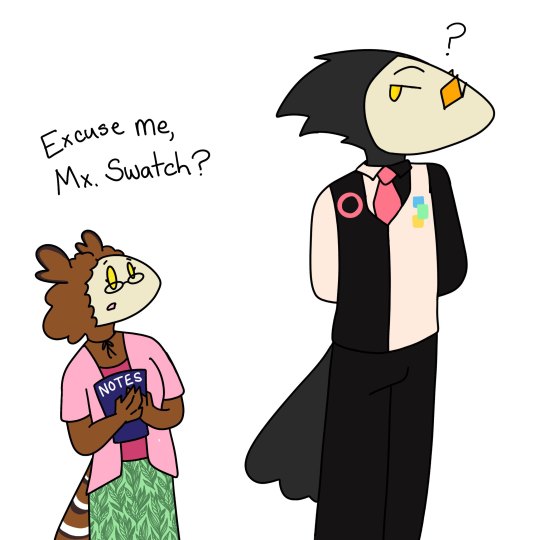



Page is trying to find other witnesses to the bizarre Mansion Cryptid, the Loch Ness Shaplin (copyright @m-chromatic). And here we see Page observing the simp in it's natural habitat:

Shaplin is such a fun character to draw, @m-chromatic! <3
45 notes
·
View notes
Photo
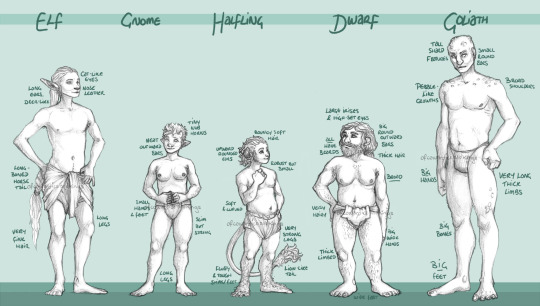
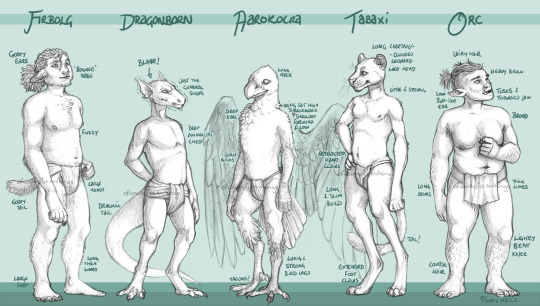




UH WHOA not only am i posting art but theres so much of it lmfao
ive been meaning to do this for mmmm a long time, and i decided to get it cleaned up so i can present folks with my homebrew/headcanon/thingy for the d&d playable races !! i know ive missed a few off but these are ones ive seen more of over all in my own travels in Nerd Game lol
ive only DMed one thing so far (our lost mines of phandelver adventure was a total blast but oh boy the shenanigans) but im like ... drowning in it all, have been for a loooonng time since i first played Neverwinter Nights when i was like 11, i just didnt have a party to mess with yet lmao (fingers crossed our schedules get sorted so the campaign goes ahead soooooonnn).. so ive been developing some of these various homebrewy headcanons for uh over half my life
getting them all together in one place like this was unbelievably fun !!
gonna yell under the cut for a bit about it more but very shortly i’ll be opening for d&d character / item / creature commissions so watch this space or pop me a message to get in a queue <3
these headcanon things are half based on “that looks cool” and Sciencing. a lot of the more humanoid in some way races ive really pulled on human ancestors a lot, as well as muscle development in different sports. And Animals, because ye
i haven’t included humans in this mammoth endeavour because we should all know what a Human People looks like, and their proportions aren’t any different in the world of D&D i run at least lol
similarly, because they’re an exact intersection between humans & either elves or orcs, the half-species arent included on here either [shrugs] i WILL talk about them some here though !!
i might eventually update this with some npc generators ive made using my own descriptors and headcanons >.>
ELVES
av height; 5′6 | heads-high; 8.5
generally long limbed, with fine wispy hair, elves senses are very heightened. helping in this, their eyes are almond-shaped with slightly narrow pupils, their large radar-like ears are very mobile, and the underside of their noses are covered in a lightly damp pitted leather. part of their ability to maintain grace with an elongated frame, aside from longer springy feet, is aided by a tail built somewhat like a horse, with a skirt of hair down its length, only with a slightly longer bone to it than would be seen in the typical pony. excepting a very light dusting on their lower limbs, they typically have very little body hair. sometimes their skin shimmers, or freckles sparkle.
GNOME
av height; 3′6 | heads-high; 6.5
gnomes are almost like diminutive elves with a few key differences. their hair tends to be wild if left alone, but is often styled wildly anyway. set rather low on rounded but long faces, their large almond eyes are keen, and small hands very nimble. it’s not sure if its due to their close environments or frequent encounters with accidents in experiments, but their skulls are surprisingly hard, and they possess small horn nubs made of bone and coated in keratin. their small petal-shaped ears are set low and point outward, and are able to move a little to catch sound. they may look fragile due to their size and build but they are pretty hardy and more than capable.
HALFLING
av height; 3′ | heads-high; 6
a very hardy but soft and welcoming folk, halflings are built for walking and surviving well, often coming from a semi-nomadic tradition. they typically have round faces with stronger jaws and soft round eyes, and their large ears are pointed upright. their figures easily get a little curved and chubby, especially when they have easy access to decent food, in preparation for harder times and the odd period of hunkering down for some downtime, say in poor weather. truly the most functional part of a halfling is their short powerful legs with big fairly flexible hard feet, and lion-like tail for balance, both insulated by hair.
DWARF
av height; 4′3 | heads-high; 6.5
dwarves are accustomed to life in tougher terrain, typically with large parts spent in the ground. their broad frames are also squat down with thick short limbs, for huge power and for life in tunnels. wide feet keep them steady and sensitive to significant seismic energy in the earth, and wide hands aid in their work and the feel of the rock. their large round ears stick outward and are slightly mobile, large noses help condition the air, and high-set eyes with huge irises aid their vision in darker spaces and the ability to peek over things without being fully exposed. their skulls are also very thick just in case of falling rocks. all dwarves are very hairy and grow beards, taking pride in keeping and styling it.
GOLIATH
av height; 7′6 | heads-high; 10
a totally different variety of rock & mountain people to dwarves, they do share a few traits. a goliath’s thick limbs are long with a big reach and huge stride, with big hands and feet for steady movement. as well as being hugely tall, they are broad, especially in their shoulders, with a long neck elevating their head further. their facial features tend to be very sharp, but long. they have little to no body hair, and they often dont grow head hair either, but decorate their skulls with tattoos. as they get older, the upper surfaces of their body develop pebble like growths under the skin, often in similar patterns to their habitats.
FIRBOLG
av height; 7′6 | heads high; 9
firbolg typically live in deep forests but are actually a giantkin - although not too unbelievable given their huge height and thick build. large parts of their body are hairy, nearly furry, and their head hair is thick and wild, and they often have facial hair too. their large heads have long thick noses with an almost bovine leather to their top lips, and wide set eyes. their fluffy ears are very mobile, but when relaxed they drop and point downward. their nails are thick and sturdy, aiding in being even more dexterous while being so big. sometimes they are covered in layers of clothing, but they possess a tiny goat-like tail.
DRAGONBORN
av height; 6′6 | heads-high; 8
dragonborns diverged from true dragons in the ancient past, likely due to a strong magical influence of some kind, but not so long ago that the bloodlines of dragons are absent from the race of dragonborn. (the illustration shows the typical head-shape and placement of ears, each bloodline has its own features). their chest is still very round like an animal, with deep chest muscles, a slightly less mobile shoulder, and short upper arm. their 4 clawed hands and feet somewhat resemble that of a true dragon, but smaller and a little less dangerous. the length of a dragonborn’s tail can vary from just the length from hips to floor, or up to their full height, and as well as being very useful for balance and dexterity, can be used for fighting. different bloodlines can interbreed, with it being a matter of chance which line is present in offspring (although metallic is more dominant over gemstone, and chromatic over both ... (ah yeah gemstone, ill get to that soon))
AARAKOCRA
av height; 5′ | heads-high; 8.5
as an avian species, especially one capable of flight, the aarakocra’s bones are hollow, making them on the one hand very agile but a little fragile. their large wingspan nearly brushes the floor, and their wings attach high on their back, through to a deep avian keel. their arms have a long forearm, which is covered in bird-like scutes, and their 4 clawed hands are still remarkably talon like which quite short palms and very mobile thumbs. their legs are very long and powerful, and backed by a typically wedge shaped tail. more often than not, their physical appearance takes after raptor species of birds, but different populations can trend towards many different appearances, including parrots and waterfowl.
TABAXI
av height; 6′6 | heads-high; 9
tabaxi are an unusual sight in many places still. their cat-like bodies are very flexible and suited to their athletic climbing lifestyle. their long hands and feet have very a powerful grip, and they can retract their front claws. their long feline face is something like a cheetah or a clouded-leopard, with large highly mobile ears, large eyes and a strong nose.
ORC
av height; 6′6 | heads-high; 8
orcs are very powerfully build, with heavy muscles and thick bodies overall. compared to other humanoids they can look a little gorilla-like. their short legs are usually a little bent to carry weight better instead of busting knees when locked. their course wiry hair grows profusely all over their body. their strong nails often grow out a little pointed. their large thick heads have high heavy brows and protruding lower jaws, short round noses and low bud-shaped ears which stick outward. the lower jaw and sometimes upper contain tusks, sometimes multiple tusks, which are greatly cared for and very impressive.
HALF-ELVES
av height; 5′6 | heads-high; 8.25
a half-elf’s build will be somewhere between human and elf, often inheriting something of an elf’s eyes and nose leather, shorter elf ears, and maybe a small tufted tail something like a rabbits
HALF-ORCS
av height; 6′ | heads-high; 8
a half-orc’s build will be somewhere between human and elf, often inheriting something of an orc’s skin colour and dark and profuse wiry hair, shorter orc ears, and some small tusks.
GOBLIN
av height; 4′ (stood straight) | heads high; 5.5
bat/cat-like ears, nose something like bear/cat, domed head, arms/legs same length, sparse wiry hair, claws, short digits, lithe but very strong and hardy
HOBGOBLIN
av height; 5′3 (stood straight) | heads high; 8
bat/cat-like ears but pinched at the base, nose something like bear/cat, very domed head, arms slightly longer than legs, claws, sparse wiry hair, quite broad
BUGBEAR
av height; 7′ (stood straight) | heads high; 7.5
bat-like ears, long domed head something like a lion/bear, arms very long, nearly totally covered in thick fur, big tusks and often fangs, very bear-like hands/feet, big claws, very broad
TRITON
av height; 5′2 | heads high; 7.5
lithe but well muscled, quite streamlined for a humanoid, frilled ears, pretty flat face, fins on limbs/back, “hair” is tendrils/fins/etc, short strong legs & long arms, long webbed fingers, long flipper feet, gills along front/side of chest
YUAN-TI PUREBLOOD
av height; 5′9 | heads high; 9
domed angular faces, lips are not humanoid, triangular eyes, scales, quite flat nostrils with sense pits following along underside cheekbones, very little cartilage in ear, some may have cobra hoods extending out of ear instead, very tall and thin with small hands/feet, reptilian claws
CENTAUR
av height; 7′ | heads high; 10
fairly stocky pony body (usually about 4′10 at withers), very muscled front end, long neck & sloping human-shoulders, long faces with long broad noses, prominent lips, horse-like ears sticking up and out, their whole scalp can grow hair but shaved sides are common, can grow hair nearly all down human-spine
KOBOLD
av height; 2′6 | heads high; 5.5
almost alligator-like head & eyes, tiny nub horns, quite animal-like chest, arms/legs same length, thick stubby tail same length of body, 4 digits with stubby claws, lithe but strong for their tiny size
KENKU
av height; 4′ | heads high; 5.5
corvid features, deep chest but no keel, longer arms than legs, 4 digits with talons, hands human-like but scaled, wedge-like tail half of leg height, not-quite fully bird feet.
LIZARDFOLK
av height; 6′6 | heads high; 7
iguana-like, egg-shaped head, neck wattle, line of back spines varies in height, long arms and legs, very reptilian hands and feet with long claws, elbow spikes
GRUNG
av height; 3′ | heads high; 6.5
large heads, neck leads nearly directly into torso, super flexible, very long limbs, triangular body, short upper arm, shorter thigh, large hands/feet, 4 digits
LOXODON
av height; 7′6 | heads high; 5.5
large head, trunk as long as torso, short legs / long arms, huge bones under thick muscle, thick skin, 4 digits with thick nails, large hands / rounded cushioned feet, v e r y broad and thick build, small tail with tuft at the end,
TORTLE
av height; 7′6 | heads-high; 7
thick wrinkled skin encased in huge shell, stooping posture with neck extending forward, very long arms & short legs, 5 digits with reptilian claws, boxy head, heart shaped from above with features set far forward, tail to balance stoop
MINOTAUR
av height; 7′ | heads-high; 9
powerful build with thick bones, typically well muscled, bovine head on thick neck, often very large horns, fairly long tufted tail, big hooved feet, broad 4 digit hands with thick nails, hair length varies
PLANE THINGS ???
listen this was a lot easier in the edition i first encountered lol
anyway, until anything else comes up in extra material im just applying a few square & rectangle venn diagram rules
a useful word; planetouched. i dont really know why WotC seems to have dropped that term for at least 5e (i missed 4e entirely) but it refers to a “mortal native outsider” with lineage or influence from a plane other than the material, so “a material plane native creature with non-native plane influence, which can die”
GENASI
height depends on material plane parent
the result of a material plane / elemental pair (usually genies). they usually take after their material parent in build and broader features, but their elemental heritage comes through in features like magical hair, bright coloured eyes, unusual body temperatures, innate magics, etc.
genasi can interbreed with themselves, and the crossing of two elements can produce some interesting results (im working on that :>)
TIEFLINGS
height depends on material plane parents
this is the first of the squares & rectangles, and tbh its basically canonical. a tiefling is the result of a material plane humanoid being born with fiendish* influence. the word ‘tiefling’ refers specifically to a human with fiendish influence, but is also an umbrella term for ALL fiendish planetouched creatures. these DO have some names mentioned in the play material ! fey’ri = elves, tanarukk = orcs, wisplings = halflings, maeluth = dwarves, etc.
so all fiendish planetouched are tieflings, but not all tieflings are human-based. the fiendish influence can be dormant for years or just string along for decades.
AnyWay, all of them have horns, most have tails, odd skin or eye colour, and others can have all sorts of extraplanar features.
*(fiends are another venn diagram thing in D&D, its an umbrella term for both demons and devils)
AASIMAR
height depends on material plane parents
aaand this is the second of the squares & rectangles, the not-strictly-canon one. okay duplicate what i said about tieflings, but make it about celestials not fiends, basically lmao. aasimar is an umbrella term, but also a human/celestial planetouched specifically! unlike the above, since its my homebrew concept i dont have other words specifically for other races’ celestial planetouched, but i’ll get there watch this space lol
EnyHoo, they all tend to have a strange glow about them in general, but usually in their eyes, and maybe hair especially. it isnt uncommon for them to have a kind of halo around themselves, or glowing glyphs/runes/sigils on or around them either. while MOST dont have full wings, a dusting of feathers isnt unusual. the features of celestials can vary a lot more. for example, unicorns and leonals are actually celestials!
aaand the slightly odd-ball;
WARFORGED
height depends on build purpose
these are an interesting case, as warforged are actually constructs, brought into this world by the fusing of organic muscle (like wood or leathery material) to an inorganic shell (like stone or metal), imbuing a life-giving fluid of some sort to act like blood, and bringing life to it by a powerful ritual - a unique glyph etched into their heads. as their name suggests they are usually created to become soldiers, or other army positions, although they could be suited to other purposes. unlike most constructs, they are fully self-aware and have a mind on par with humans. they do not need sleep (but require rest) and they also do not naturally reproduce. if they live longer than their purpose, then they are turned loose to deal with the world as they wish.
as they are MADE they can vary greatly depending on who made them, and for what exact purpose - although they tend to have beak-like mouths, and 3 digit hands and 2 toed feet.
AV. HEIGHT CHART FROM LEFT TO RIGHT !!!
human - elf - dwarf - gnome - halfling - orc - goliath - firbolg - dragonborn - aarakocra - tabaxi - kenku - hobgoblin - bugbear - yuanti - triton - kobold - grung - lizardfolk - tortle - centaur - minotaur - loxodon
oooboy that was a lot of waffle :L
#dungeons and dragons#dnd#elves#dwarves#gnomes#halflings#hobbits#orcs#goliath#firbolg#dragonborn#aarakocra#tabaxi#kenku#goblins#hobgoblins#bugbears#triton#kobold#grung#lizardfolk#tortle#centaur#minotaur#loxodon#genasi#elementals#warforged#tieflings#aasimar
3K notes
·
View notes
Text

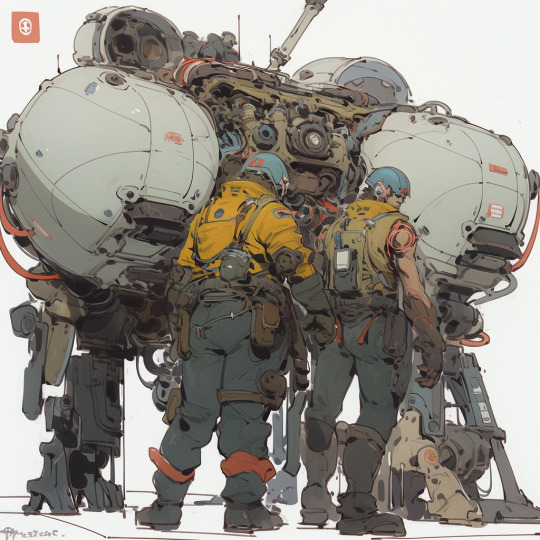
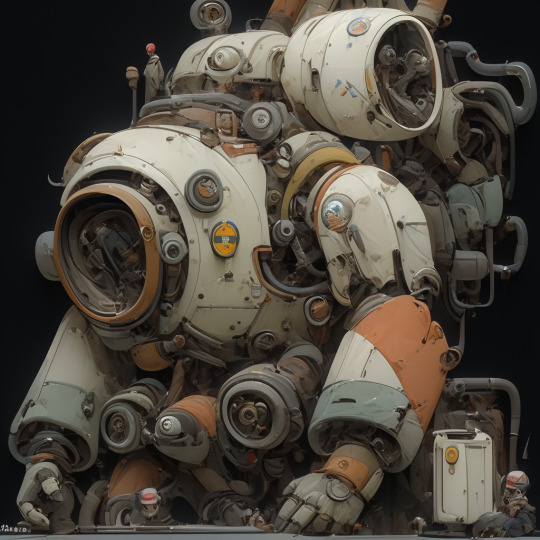
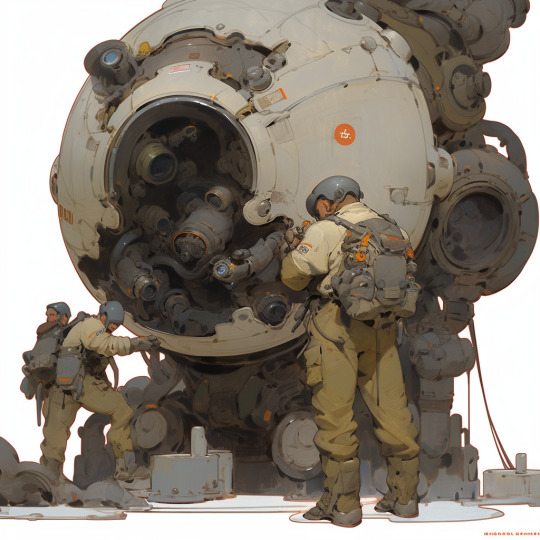


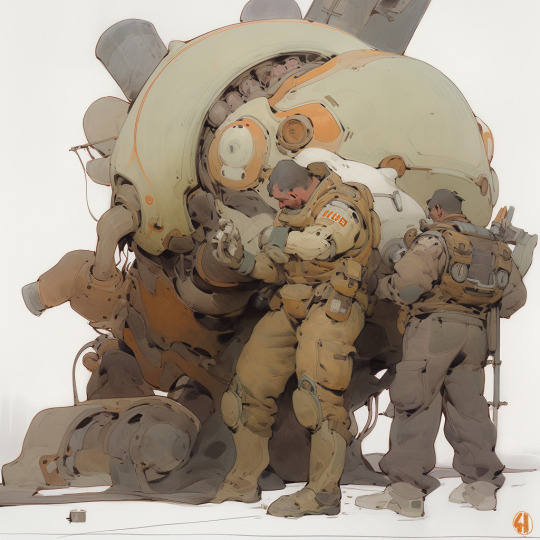

By Sandu
Prompt:
Around a emotional streamlined military construction massive ancient robot gorgeous Aliens movie mecha, dark gorgeous chromatic harmony pulp art chromatic balance frank frazetta translucent UFO engine, mechanical complexity, miner with giant astro robot front view examining the strange rocket engines, close up, helmet and gloves off on the side, tattoos on hands and face, punk style, happy, habitat in space, medical space station giant module, engine toroidal, massive, close up street view going to the sky, impressionism oil painting, armored spaceship, eerie Sandu Baciu style, mid day god rays, steven holl, detail textured, rectangular fields, extreme angle, pastel volumetric light at dawn, octane render, packed with hidden details
--q 2 --niji 5 --s 222 --style expressive
#nestedneons#cyberpunk#cyberpunk art#cyberpunk aesthetic#cyberpunk artist#art#cyberwave#scifi#scifi art#scifi aesthetic#retro scifi#retrocyberwave#astropunk#line art#mecha#mechacore#galaxy#galaxycore#pastel colors#bot#cyborg#robot#lonely robot#ai art#ai artwork#ai artist#aiartcommunity#midjourney#prompt sharing#promptsharing
98 notes
·
View notes
Photo

June 21st is...
Arizona Day - Arizona became a state on Valentine’s Day in 1912. Arizona is home to the oldest continuously inhabited settlement in North America. Established around 1000 A.D., the village of Old Oraibi is located on the Hopi Indian Reservation in Navajo county. Known as the Grand Canyon State, Arizona brings the wilderness to you. The breathtaking views of the Colorado Plateau, which incidentally took over 70 million years to form into towering stone, are now one of nature’s grand centerpieces.
Day Of The Gong - Mighty and gentle, earthy, and celestial, this extraordinary instrument is a conduit of Creation. With an international cultural history, the gong offers sensory and multi-dimensional sounds. Thanks to artisans worldwide, gongs come in an array of sizes, designs, and origins. As an instrument, they are both beautiful in design and performance. While gongs originate in the East or Southeast Asia, they also have an ancient history in Rome.
Daylight Appreciation Day - It recognizes the summer solstice (the longest day of daylight in the northern hemisphere) and encourages people to celebrate the many benefits of the sun.The day also offers an opportunity to learn more about the importance of daylighting. Daylighting is using skylights, windows, and other architectural openings to naturally light interior spaces. Doing so helps not only to reduce energy consumption but may also have health benefits.
Go Skateboarding Day - Retailers, sponsors, parks, and individuals around the world host events showcasing this rebellious and creative culture. A combination of athleticism, dance, and art, skateboarding has grown up in an urban world. It also crosses multicultural divides and speaks to a diverse population. Skaters test the laws of gravity with a variety of ariels and twists, thrilling their fans.
Indigenous Peoples Day - It’s all about bringing people together from different walks of life to share in the contributions of Indigenous People to our society. You’ll find an eclectic mix of contemporary and traditional music while learning about how Indigenous Peoples helped to develop our agriculture, language and social customs. The day is also about how governments are creating crucial partnerships with Indigenous Peoples to protect their land, heritage and culture in modern times.
International Yoga Day - One of the best and oldest ways to release the tension building up in both the body and the mind is practicing yoga. The benefits of practicing yoga, such as mastering countless techniques of controlling the body and the mind, have been widely recognized by the Western world for years, and International Yoga Day aims to continue to inform people how much dedicating a bit of time to the art of yoga can improve their lives. It is not just a physical practice, but also a mental one, with many of the teachings of yoga reflecting mental and spiritual states, and allowing your body to wander and drift into unknown realms that will give you a focus in your life and a calmness with your soul.
Peaches ‘n Cream Day - Peaches’ n’ Cream is a simple, traditional, and delicious summertime dessert. Make some homemade vanilla ice cream to sweeten the deal, and your peaches’ n’ cream will be all the cooler
Selfie Day - While the act of taking a selfie may predate social media, smartphones, and the word itself (which is now in the Oxford Dictionary), the popularity of taking these self-portraits keeps increasing. And the ability to take them gets easier all the time. Selfie sticks and multi-functional camera phones make it all too convenient to take these kinds of photographs as well as group selfies (aka groupies).
World Giraffe Day - Whether you’re into conserving their native habitats, enjoy hanging out with our necky friends at the zoo or you just appreciate the joy of nature’s most weird and wonderful creatures, World Giraffe Day is a day of observance when you can really put your neck out!
World Humanist Day - There is a philosophy of belief that indicates that humanity is more than just the puppets of some divine being or subject to a list of metaphysical oddities and creatures with their own designs. Instead, humanism believes that we are whole in and of ourselves and that our good behavior and civility is not reliant on anything except a true and honest desire to be decent people. Most of all this philosophy raises the importance of personal responsibility, if we behave as monsters, it is we who are monsters, there is no “The Devil Made Me Do It”. World Humanist Day celebrates this ideology and those who practice it, bringing reason and science to the world of faith and irrationality.
World Motorcycle Day - Today motorcycles are used for an increasing number of applications, including delivery driving, passenger conveyance, recreation, and even just daily commuting. This is due, in no small part, to the incredible gas mileage these vehicles get, and how compact and easy they are to store even if you live in an apartment. Whether you’re using your motorcycle to get around from day to day, or are an enthusiast or hobbyist who goes on long rides as part of your yearly vacation, World Motorcycle Day is for you.
World Music Day - Music has existed for as long as mankind has found its voice, and quite possibly before. Every culture of the world has its own form of music, as distinct and unique to its area as language and cuisine. In the western world, we are familiar only with scales, known as the diatonic scale which should be familiar to anyone who took music classes or choir in school. But this is not the only or even the first scale that music can use. There’s the chromatic scale, which has 12 notes instead of the 7, and the octatonic scale, which has 8 notes, but these are just the beginning. In every part of the world, there are different scales and musical formats used, and these create a form of music that has its own signature. Then when you add in the cultural themes, the variety of instruments, and the forms of voice singing that can go along with it, music is a truly endless adventure. World Music Day celebrates this adventure and those that dare to take it.
#arizona#gong#daylight#skateboard#indegenous people#yoga#peaches n cream#selfie#giraffe#Humanist#motorcycle#music
16 notes
·
View notes
Text
My Attempts At Making Unique Nonhumans Part 5: Dragonborn!
This is gonna be a long one my friends, so buckle up. (This is part 5 of this series, to see the others just go through the “Nonhuman series” tag on my blog!). Also, some of these changes will kind of retroactively apply to true dragons as well b/c of how this all works.
Taglist: @talesfromaurea @hellishhin
•
General:
Dragonborn!! I have changed a LOT of what goes on here. I actually changed the origin of dragonborn itself even. In my mind they’re just another in the same family as dragons, literally just humanoid dragons. The first dragonborn were much closer to their true-dragon cousins (wings and etc), but over time the dragonborn have become more and more different as evolution happens. There are some dragonborn who are more draconic than others, but those are usually small, ancient, and isolated pockets. This all also means that the lines can get blurred when it comes to dragonborn, and often with dragonborn they are either clearly similar to the common attitude of their true dragon counterpart or completely different. It depends on many factors, obviously, especially their upbringing and culture. Another thing I changed was their lifespan, because it’s such bs that the DRAGON species isn’t long lived. That’s like a whole thing with dragons, it should be reflected in dragonborn too. So, in my world, dragonborn tend to live a long time, anywhere between 250 and 600 years or so. They’re roughly on par with dwarves, if not slightly longer-lived. Another thing dragonborn have is the ability to unleash a roar that sounds like a full on dragon (like Shakari did during the battle at Dymea’s hideout). This is often used for battle cries and other similarly dramatic things. (Imagine an army of dragonborn unleashing a war cry. It’s a common tactic to instill fear in an enemy and it works pretty much every time.) Additionally, their scales, in classic dragon fashion, are like iron. Most dragonborn use their scales as natural armor because it’s easy and pretty effective. Another thing is that dragonborn have senses that rival even the elves, because that’s another iconic dragon thing that I felt that they deserve. I’ve also decided that because I personally adore tattoos, it’s very sad that dragonborn and other scaled species couldn’t have them, so I’ve invented a special “scale-paint” that allows permanent marking on dragonborn and other scaled folks. I mean, there’s always magic, of course, but scale-paint is generally easier. Last thing I added here is that very very powerful dragonborn sometimes gain the ability to shift their form, just like ancient true dragons, but it is extremely rare.
Metallic/Chromatic:
Okay, so, metallic and chromatic dragons. Honestly, in my world, the difference between the two is negligible at best. They’re just two different groups of dragons. I don’t like that one is evil and one good because that’s boring. Plus, I mean, why would a dragon, an ancient creature with vast knowledge and power, never be able to learn or change its behavior? Doesn’t make sense. Of course the distinction is even further reduced with dragonborn, to the point where gold and red are just scale colors and you can guess pretty much nothing based on that. Although, I did take away the Paralyzing breath in both the metallic true dragons and metallic dragonborn, instead just sticking to the one option. I also feel like chromatic true dragons should be able to shape-shift as well, so I did that too. Anyways, on to the colors! Gonna put it under a cut because again, this is a long one.
Red:
Red dragonborn! Most dragonborn, the closer they are to their true dragon relatives then the stronger and more numerous the traits they share with them will be. Some common things to see in reds are extra large horns, serrated claws for climbing mountains, and gray/black/brown undertones that would help blending in in the mountains. It’s also very common for their breath to smell like smoke, obviously, and for their bodies to be extremely warm. Red dragon scales are prized for giving off intense heat even years and years after death, and some red dragonborn scales have the same warmth. Red dragonborn also have the strongest scales of most dragonborn besides black, even to the point of reinforced scales in impact heavy areas (allowing for tumbles down mountains without severe harm). This helps more with true dragon hatchlings learning to fly in the mountains, but some red dragonborn inherit it as well.
Blue:
Blue dragonborn tend to vary a lot in how actually “blue” they are, seeing as how blue is quite possibly the worst color for surviving in the desert, the usual habitat of actual blue dragons, when you can’t fly (unlike true blue dragons, who it works for because they can hide in the sky). So they go from brownish muddied blue to straight up sapphire depending on how necessary camouflage was in their genetic history. Besides that, they have a few traits that, again, vary depending on how distanced they are from true dragons. Examples are scales/a horn that easily conduct electricity, a system for conserving water that runs just beneath the scales, special markings around their eyes that help them see in the sun (much like a cheetah), and a smell of ozone. Their breath/their inherent electrical charge can be used for a lot of purposes, from excavation to glass sculpture. (I like to imagine little baby blues making sandcastles and then their parents turning them to glass with their breath and saving them later.) I imagine glass art is probably common with most of the heat based dragon types, actually.
Green:
Green dragonborn, unlike most others, have to be far more careful with their breath weapon. They have venom sacs and a special organ to hold the toxin they can breathe, but it’s hard to tell the difference, especially for young greens. They’re a bit like vipers in that sense, that the babies can barely control their venom. Some common traits green dragons can have is obviously their camouflage in forested areas. Their scales often have a slight shimmering layer so that even in dappled/varied light they can remain stealthy. Green dragonborn also obviously have a super boosted immune system in order withstand poison (and not just their own). They usually are also the only dragons/dragonborn who lack horns besides occasional smaller and more antler-like ones. They also have can have a leaflike texture to their fins and frills that can help collect water (and also serve as a way to regulate a bunch of bodily functions. For example the fins would serve a similar function to sweat, among other things.), and even gills in some cases.
Black:
Black dragonborn have the strongest scales of any dragonborn besides red, as their scales are built to withstand their acidic saliva. Black dragonborn, like black dragons, are unique from other dragonborn/dragons because a lot of their bodies can be worn away or decaying before they die, because their organs just... don’t. Similarly to their saliva, their stomach acid is even more powerful. It is the most potent acid known to mortals, and black dragonborn often carry on this trait. It’s said a black dragon’s stomach acid can melt through almost anything, and because of this, acid reflux can be deadly to young dragonborn who haven't fully developed the acid-resistant coating on their throats and organs yet. Some other common traits are gills (for swampland living), and longer claws that can be used for slashing or stabbing (helps when spearing fish).
White:
White dragonborn tend to be the biggest dragonborn since they need the protection from the cold. They are still cold-blooded, like other dragonborn, but the ideal temperature is much lower for them. I also gave them horns, but not normal horns, something more akin to mammoth tusks. So white dragonborn also tend to have tusks. Additionally, white dragons have these strange quills along their spines that create a chilling sort of howl when rubbed together or a when a breeze blows through it right, and white dragonborn have these too. They’re often used by hatchlings and mothers to find each other. Another common feature is having huge and occasionally webbed feet/hands for running in snow without sinking (or swimming), like built in snowshoes. They are another type of dragonborn/dragon that also commonly has gills.
Gold:
Gold dragonborn, the shiniest of shiny. Also, funnily enough, the dragonborn with the weakest scales (which is really not very weak at all, by the way. Iron can still break on them). Of course, though, this is often used for body art. Gold dragonborn often semi-melt their scales’ outer coating with their fire, and then create all sorts embossings and patterns on themselves before it cools. Best part about this is it can be redone if they get bored (which can happen when you live 500 years). Only thing is this can further weaken the scales or cause damage if done too many times. Some other common traits are their fins, which work very similar to those of the green dragonborn.
Silver:
Silver dragonborn!! I so rarely see metallic dragonborn in my personal games, actually, but I admit silver dragons/dragonborn are my favorite. Silver dragons in my world have a triceratops-like plate/crest on their foreheads that they use to bash into one another in fights (and to break rocks), so silver dragonborn tend to have something similar on top of their heads. Another interesting part of silver dragonborn is that while they speak draconic naturally, their tongues are actually so flexible and their vocal cords so versatile that they are able to mimic most speech they hear, and learn how to pronounce almost any new languages very quickly, a benefit they gain from the habits of silver dragons to visit along mortals. They also have a much higher tolerance for thin air, and their true dragon counterparts can fly the highest into the atmosphere of any known dragon. They also have the same malleable scales as the gold dragonborn, though slightly tougher, and claws that are serrated like reds’ are.
Bronze:
So first things first, I have changed some things even with the true dragons. I have switched the habitats and breath weapons of bronze and brass dragons. Bronze dragons now live in the hills/plains and breathe fire, and Brass dragons live on the coasts and breath superheated air/steam. Besides that they are generally the same, however. Regardless, bronze dragonborn. They too have malleable scales, though they will retain their shape much better and are far stronger (as well as requiring more heat). The bronze dragonborn tend to have similar adaptations to the blue, like the eye markings. Their horns/crest are slightly different though, since they don’t need to conduct electricity. Some common features among bronze are serrated claws for rockier areas, or large feet and tail for balance on sand (which blues would likely have as well).
Brass: Brass dragons/dragonborn are a little weird but I like em. They normally breath superheated air BUT they can scoop down into water and gulp some of that and if they have excess can turn their breath weapon into steam instead through use of a special organ. Also they of course have gills and webbed claws, as well as scales that have a sort of water resistant coating that helps them glide in and out of water. They also have eye markings to help them see despite glare of sun on the water, so the brass dragonborn may inherit many of these. Brass dragonborn also have the malleable metallic scales, just less so than others because the waterproof coating makes it difficult. They also tend to have extra strong gator-like tails.
Copper:
I also changed coppers up! It felt weird to have the acid one in the desert, so I changed it up and gave the coppers lightning. Like blue dragonborn, they can have many desert adaptations alongside their conductivity in their scales, interesting thing about coppers is that they have the fins like greens, but they are used slightly differently. Mainly they’re used to feel changes in the air (when a storm is coming and etc) but they can also release heat, and can press down against their bodies to prevent damage. Coppers (and blues) are also generally good at burrowing in sand, and often you’ll see coppers leaping in and out like scaly sand dolphins.
Iron:
Ah look! It’s me, I did another thing. I may have created a whole new type of metallic dragon. Behold, the Iron Dragon. These guys live primarily underground, and are generally slightly smaller than other dragons, using their wings more like bats use theirs, flitting around cave ceilings (also they are blind and have echolocation also like bats lol). So Iron dragonborn inherit many of these, and since they live underground, often interact less with other dragonborn and surface societies, and usually retain much more of their draconic traits. Their scales are malleable as well, and possibly some of the strongest. Iron dragons/dragonborn also breathe a thick, heavy smoke, that serves both a a noxious cloud and a way to blind their enemies (since they use echolocation anyway).
Gem Dragons:
honestly? Not really sold on em yet, so there’s none in my world. Could change though, I dunno.
•
Ah this was fun. Enjoy dragonborn immensely, now they have some extra fun flavor! Yay! Feel free to leave suggestions for next week, I’m thinking probably either Kobolds or Orcs? Still not sure though.
#not story#long post#worldbuilding#wbw#(late again tho)#Nonhuman series#here be dragons#>:)#love me some dragons#how to train your dragon remains my favorite series of dragon books#possibly my favorite series of all time actually if we’re being honest#and every day i feel the urge to make a d&d setting with those kinds of dragons in it instead#maybe one day
6 notes
·
View notes
Text
Iris Publishers - World Journal of Agriculture and Soil Science (WJASS)
Side Effects of Insecticides on Beneficial Insects: A Practical Tool to Identify Organic Agroecosystems
Authored by R González Ruiz

Introduction
In order to achieving sustainability, integrated pest management (IPM) represents a remarkable improvement over previous conventional approaches [1]. This crop production and phytosanitary protection model combines different management strategies and practices for healthy crops, to bring the pest organism to acceptable limits with the least possible ecological disturbance [2]. This includes the establishment of population thresholds for pests, which determine the need for chemical control, minimizing risks to human health and beneficial organisms. Currently, an area of 392,362 hectares of olive groves corresponds to IPM in Andalusia (southern Spain), which according to the regional government, it represents 71% of the total area dedicated to olive cultivation.
IPM does not necessarily require the suppression of insecticides, but rather affects the need to reduce their dependence, by eliminating unnecessary applications. A well-developed IPM program, based on science, provides a wide range of techniques and offers new possibilities for pest control, which is obviously dependent on the use of pesticides [3]. In spite of this, insecticides represent essential elements on which the sustainability of an integrated management program depends, and it is very likely that this will continue as long as these products are available, effective and economically available [4]. With this objective, IPM programs resulted in safer and more judicious use of pesticides, flexible enough to integrate information about their impact on pests and their natural enemies, maintaining the quality of the ecosystem [3,5].
Among the IPM objectives are to successfully prevent the emergence of resistant populations, protecting beneficial insects by enhancing their action [6], which has been focused on: i / The conservation / enhancement of natural populations of beneficial insects through to effective management of the agricultural environment (natural control), and ii /The increase of their populations through mass releases in the area of cultivation (biological control). Both allow to manage the pests efficiently and are compatible with the environment and with other control tactics [7,8]. First point includes habitat management, such as the establishment of an herbaceous plant cover, which, in addition to limiting the erodibility [9], is intended to enhance the natural control mechanisms [10-17].
Since insecticides constitute an essential part of IPM, this approach makes it necessary to evaluate their impact on beneficial fauna [4]. Most of the existing studies analyze the lethal effect of insecticides, including synthetic and natural products, but research on the sub lethal effects is still scattered. In field crops, lower doses / concentrations of insecticide occur, after the application is degraded by factors such as rainfall, temperature and sunlight. This means that a great proportion of non-target insects are mainly affected by sublethal dose/concentration values [18]. A sublethal dose/concentration defined as inducing no apparent mortality in the experimental population [19]. It is stated that, in general, doses / concentrations of insecticide below the lethal median (LD50 / LC50) are considered sublethal [20]. Sublethal effects have been described affecting biology, physiology, or behavior of individuals or populations that survive to the exposure to a toxicant at lethal or sublethal dose/concentration [4,20]. The sublethal effects may be manifested as reductions in life span, development rates, population growth, fertility, fecundity, changes in sex ratio, deformities, feeding, searching and oviposition [21-23]. The sublethal doses / concentrations of insecticides cause many alterations in the behavior of insects, interfering with their chemical communication system, thus reducing the chances of efficient localization of a pheromone source [20]. Among the induced symptoms have been described: jerky movements, overexcitation and hyperactivity [24-27]. Stimulation, as well as depression, of general locomotor behavior has also been cited, both for walking and for flying, causing uncoordinated or even convulsive movements, which therefore negatively affect reproductive processes, host location, dispersion, migration and food [4,21-23]. Nonetheless, these effects do not necessarily cause mortality of affected individuals, since the use of the term “insectistatics” [28] is suggested to apply it to those agents that can interfere with the processes of growth and reproduction, without necessarily killing. Quite the contrary, this set of behavioral modifications provide insects with an escape mechanism from the toxic effects of pesticides, which is why they have been called behavioral resistance since it provides the first barrier or mechanism of detoxification. The affected insects having this skill show hyperreflexia, with a trend to start the flight more easily [29-31].
Among the side effects of insecticides, it has been reported that beneficial arthropods are severely affected by sublethal effects [4,19,20], although their impact has often been overlooked or underestimated. The determination of the side effects of insecticides acquires special relevance when considering the evolution of their populations in agricultural ecosystems. In the European Union, the registration and selection of insecticides for inclusion in IPM programs requires knowing their side effects on non-target organisms [32, 33]. As indicated in Table 1, dimethoate stand out in olive growing, being the most common insecticide, in both Conventional and IPM, among which the main difference consists in the criteria that determine the application of the insecticide. In the first case they are applied routinely, while in IPM their use is determined by the establishment of pest’s population thresholds, which implies a considerable saving of insecticides with respect to conventional management. In view of the notable differences between them, the need to assess the impact of this reduction in the application of insecticides on the behavior of the populations of beneficial insects has been raised [34,35]. Since Insecticide applications induce behavioral modifications in natural enemies’ insects affected by sublethal doses, it is likely their effects have an impact on the capture rates recorded in monitoring commonly used in olive growing, devices, such as the sticky chromatic traps, [15,36]. In order to detect anomalies in the capture rates of nontarget insects, field experiments based on experimental insecticide applications on a small scale have been carried out, as a trigger for behavioral reactions of insects affected by sub lethal doses. The hypothesis of these studies is based on the statement that the beneficial insects under the managements that commonly include the application of insecticide (conventional, IPM) have most likely developed behavioral patterns that are a first step in acquiring resistance [4]. Therefore, insect species affected by sublethal doses would have developed lineages with behavioral modifications that would allow them to adapt to relatively frequent contact with insecticides, unlike what would happen in ecologically managed agroecosystems.
Discussion
It is obvious to consider that the frequency of the insecticide application constitutes the main limiting factor of the diversity and abundance of the community of beneficial insects. It was also one of the main triggers for the implementation of Integrated Pest Management [1-3]. However, not all IPM models have allowed the desired sustainability to be achieved, nor have they achieved the desired effectiveness, frequently due to the lack of integration and coordination of the different program elements [37]. The integration of chemical and biological control can be part of sustainable pest management; therefore, it is essential to know the lethal and sublethal effects of insecticides on natural enemies to maximize the compatibility between these two tactics. This has led to the return of insecticides as a central element in pest control, which explains why recent studies do not allow to establish a clear differentiation between the IPM and Conventional management, while its deficiencies are especially evident when comparing any of these two managements with organic management [38]. Although compared to conventional management, IPM represents an average reduction in the use of insecticides of at least 50%, it has been proven to be nonetheless insufficient to ensure the sustainability of the populations of beneficial insects and optimize their entomophagous effectiveness [35,38].
In addition to the lower diversity and abundance, the influence of the side effects of insecticides in the beneficial insects must be assessed for the correct interpretation of data from population monitoring. Recent studies suggest that, as in conventional agroecosystems, in IPM these species show very frequently behavioral resistance (BR+), while in organic crops, they lack it (BR-) [34,35]. A close relationship seems to exist between insecticide application and the development of behavioral resistant populations. This finding has suggested establishing a practical procedure based on the realization of small-scale field applications, to subsequently monitor the reactions of beneficial insects, useful to identify ecological agroecosystems, characterized by the absence of behaviorally resistant lineages. Among the species of beneficial insects potentially capable of developing behavioral resistance in agroecosystems subject to insecticide application, are species of the common green lacewings of the carnea-complex, such as Chrysoperla agilis, of special importance in spanish olive groves [35,39], the thysanopteran Aeolotrhips intermedius predator, [34] and the parasitoids Pnigalio mediterraneus, Ageniaspis fuscicollis and Chelonus eleaphilus [35]. These species have a higher capture rate in chromatic traps, which is attributed to symptoms caused by the sub lethal doses [24-27], such as spasmodic movements, overexcitement, hyperactivity, irritation / repellency reaction, thus avoiding contact with surfaces treated. These effects are common to a wide range of insecticides, including organochlorine [40,41], pyrethroids [31,41-43], organophosphates [41,44] and carbamates [41]. The set of behavioral effects are intended to avoid contact with the impregnated surfaces by the insecticide, thus chromatic traps represent shelter areas. These behavioral adaptations should lead to greater survival of the affected insects, as a first step in the selection of physiologically resistant lineages to insecticides. Regarding common green lacewings, resistance of Chrysoperla carnea has been indicated to pyrethroids, organophosphorous insecticides, carbamates [45] abamectin and organochlorine insecticides [37]. Therefore, for this type of insects, capable of developing behavioral resistance (BR +), we conclude that its higher frequency of capture in chromatic traps of treated areas can be considered as an indicator of the disturbance caused by insecticide applications.
Among the beneficial insects, a wide range of susceptibility to insecticides has been reported [37,46], which manifests itself in a different response in post-treatment behavior patterns. In this regard, it has been possible to verify that some species have practically negligible population values or are very absent in the agroecosystems subject to insecticidal applications (Conventional, IPM) while they are relatively common in ecological management [31,35]. This group includes predatory species such as snakefly, Harraphidia laufferi (Raphidioptera: Raphidiidae), ladybugs (Coleoptera: Coccinellidae) and pirate bugs such as Temnostethus sp. (Hemiptera: Anthocoridae). Its low population values in olive groves where insecticides are frequently applied could probably be due to their greater susceptibility to commercial doses of dimethoate, which would exceed the LD50 for them. Unlike species with behavioral resistance, these show a significantly lower capture rates in post-treatment chromatic traps, which allows them to be classified as BR-.
The integration of chemical and biological control is an essential part of sustainable pest management; to maximize the compatibility between these two tactics [37], for which a correct interpretation of the impact of sublethal doses on beneficial insects is required [37,47-49]. The possibility of a more accurate interpretation of the monitoring data of the field experiments based on the application of small-scale inductor treatments opens up new possibilities of practical uses and applications. Among them, it can be used in the identification of organic olive groves, since it allows a clear differentiation from those that are object of insecticides applications (conventional, IPM). It is also very useful to define more clearly the period of conversion of a crop to obtain the certification of “organic farming.” This process involves the replacement of highly polluting practices (such as the use of fertilizers, chemical pesticides, and deep soil tillage), for others that allow maintaining biodiversity, achieving the balance of fauna and flora, and ensuring the long-term productivity of the soil. During this period of agronomic conversion, agricultural exploitation is subject to frequent inspections by the institution in charge of granting certification, whose purpose is to verify the disappearance of pesticide residues and fertilizers, not allowed in organic production. This period is currently set at 3 years [50], although until now it has not been verified whether this period is sufficient to revert genetic lineages resistant to the behavior of beneficial insects to their wild form.
To read more about this article: https://irispublishers.com/wjass/fulltext/side-effects-of-insecticides-on-beneficial-insects-a-practical-tool-to-identify-organic-agroecosystems.ID.000576.php
Indexing List of Iris Publishers: https://medium.com/@irispublishers/what-is-the-indexing-list-of-iris-publishers-4ace353e4eee
Iris publishers google scholar citations: https://scholar.google.co.in/scholar?hl=en&as_sdt=0%2C5&q=irispublishers&btnG=
1 note
·
View note
Text
Oh a Wet Spider
What has a beak, 3 hearts, and can solve puzzles?
Alien???!!
Nope Karen, definitely not. It is our octopus! Last October 8, we celebrated the World’s Octopus Day! And as a hark back to them, let us dive deep to meet our ocean’s friend.
Say hi to the our little friend Octopie! She’s in the tank.
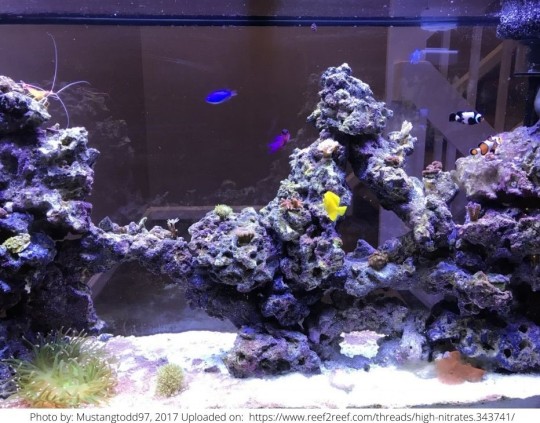
What do you mean she’s not in the tank? She must’ve escaped!

Photo from Health and Safety Authority 2020
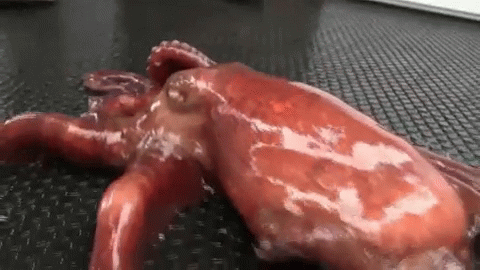
gif link: https://tenor.com/search/octopus-gifs
Oh, here she is! Octopie sometimes enjoys a good stroll around the neighborhood as you can see. She just needs a small fetch to get back to her place.
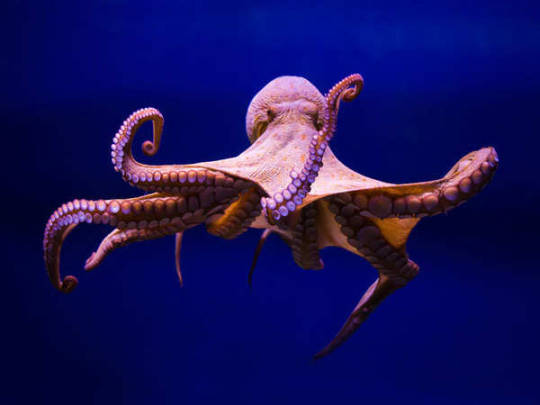
Photo from ET Bureau 2018
Classification of the Octopus vulgaris
Kingdom: Animalia
Subkingdom: Bilateria
Infrakingdom: Protostomia
Superphylum: Lophozoa
Phylum: Mollusca
Class: Cephalopoda
Subclass: Coleoidea
Superorder: Octobranchia
Order: Octopoda
Suborder: Incirrina
Family: Octopodidae
Subfamily: Octopodinae
Genus: Octopus
Species: Octopus vulgaris (Cuvier 1797)- Common Octopus (ITIS 2020)
Where do these guys live?
Just like Ursula, the Octopus vulgaris reside at the surface and depths of 100-150 meters in tropical, subtropical, temperate regions living in the benthic, reef, and coastal biomes. Mostly they have a worldwide distribution. However, they are native to the Indian, Atlantic, and Pacific ocean but also abundant in the Mediterranean Sea, Eastern Atlantic Ocean, and the Japanese water (Case 1999).

Photo from Aquamaps
Common Octopus: What’s with the Bod?
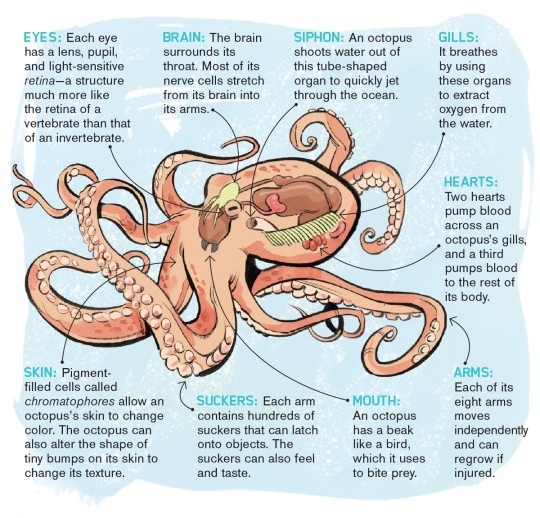
Octopus Anatomy Diagram (Anatomy Note)
They have 8 long arms where the underside of it has 2 rows of ring-shaped suction cups for grasping which can be compared with our fingers. On average each tentacle has 240 suction cups, it turns out that octopus has 1800 fingers on the 8 hands (Notord 2017). Wow, that means it can slap you eight times! Not to mention, the row of mark of suckers it’ll leave behind. Ouch!
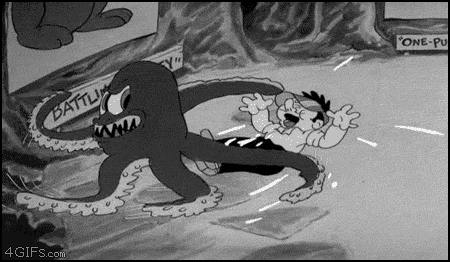
They have 3 hearts and blue blood. Two pump blood through each of the two gills, while the third pumps blood through the body. Interestingly, the head and associated sensory organs of an octopus are well developed. In this species, its head and eyes are the key characteristics of the organism. The vertical lobe of the brain of this octopus involves it to have sophisticated behaviors and learning memory systems.
The study by Bryne et. al (2014) shows that the O. vulgaris have a lateral preference on its either left or right eye in monocular vision. Their eyes are similar to the human eyes with a cornea, iris, lens, virtuous region, retina, optic nerve, and ganglion but it lacks a blind spot (WordPress 2014).
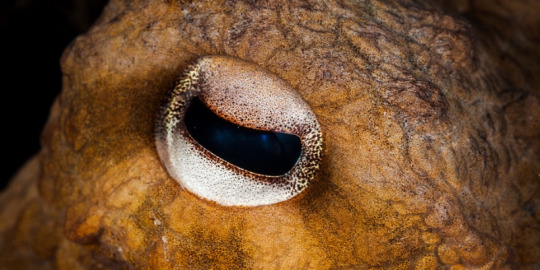
Photo from Octolab 2019
It is because of their intelligence and extraordinary suckers that makes octopus not exactly the best organism to keep as pet. They often escape their aquariums! It also doesn’t help that some of them are capable of “walking”.

youtube
Check out this video of an octopus dissection and examination of its anatomy!
youtube
Wheel of Life: Octopus saga
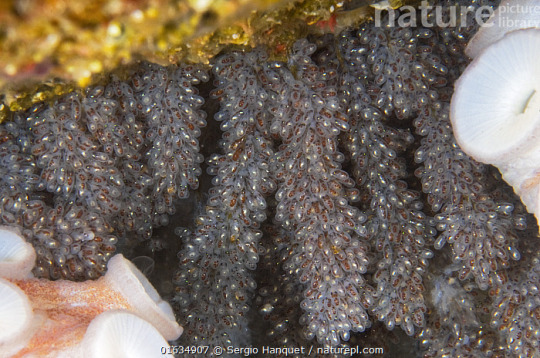
The common octopus has individuals of both sexes. The male approaches the female octopus, who fends off from him then accepts him later on. He will pass his spermatophores to her by inserting his hectocotylus, a modified arm, in her mantle cavity; for several hours for a week or so both of them will copulate.
The common octopus are oviparous and can lay 100,000-500,000 grain-like eggs in shallow water and attach them to a substrate. Common octopuses show parental care for their eggs where they rarely leave their eggs and do not eat for 4-5 months. Their planktonic stage can last for 60 days, and 30 days for their settlement. (Case 1999; MarineBio c1998-2020).
Octopus Copulating

youtube
Eggs Hatching
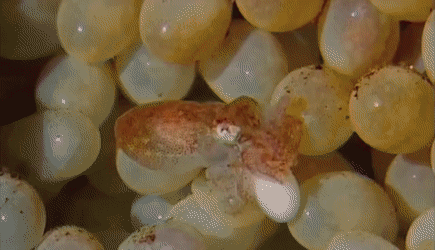
Watch the final act of a mother octopus protecting her eggs which will surely stir your emotions
youtube
Into the Unknown: Octopus and its Environment
The common octopus is able to adapt to the different habitats where they can hide by their camouflage; these octopus are able to conceal themselves in order for them to protect themselves and to feed by contracting and expanding their specialized cells called chromatophores. They are nocturnal animals and tend to be solitary and territorial but still interact with other octopus at times. O. vulgaris are known to be active predators feeding on gastropods and bivalves.
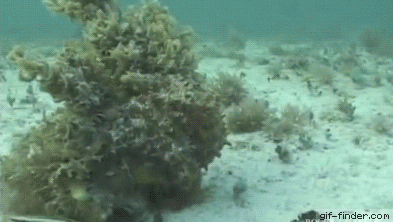
Relationship with Humans
Have you ever eaten an octopus? If yes, then you might already have an idea as to how our relationship is with octopuses. Let’s take a tour of the different parts of the world and have a sneak peek on how they prepare octopus to become a delicious meal.
Octopus inspires chefs to be creative
The consumption of octopus has been widely distributed throughout the globe, deeming chefs to be inspired by them. In Korea, octopus are eaten raw and alive while in Japan, they are prepared with flour and mixtures to create the famous takoyaki. In Puerto Rico, a known octopus delicacy called Octopus carpaccio is served. Other countries such as Los Angeles and Chicago are also equipped with their octopus dish.

Takeaway Takoyaki (by Su-Lin)
Check out this video of a popular way of eating octopus in Korea
youtube
Giving an Arm to the Economy

Photo by Rory Hyde 2008
In the Philippines, octopus are landed by small-scale opportunistic fishers that will bring any valuable catch to local middlemen (buying stations) that trade an assorted array of species for export purposes. Only a small number of processing plants in the Philippines process and export octopus. All octopus from the Philippines is exported frozen and no other, more detailed figures are available. Figures indicate that around 5,857 MT was exported in 2017, with an estimated value of 24,9 million US$.(Seafood Tip, 2020)
At a global scale, China, Morocco, Mauritania, Spain and Vietnam are the main exporters of octopus. Global imports of octopus totaled an average of US$ 1.6 billion dollars per year between 2009 and 2013. Major markets are centered in Asia and Europe, particularly Japan, South Korea, Italy and Spain.
The global appetite for octopus is growing, how about its number in the ocean?
Global octopus catch peaked at almost 380,000 tonnes in 2007, and has since declined by a tenth to 335,865 tonnes in 2012.
Didn’t see that one coming...
1. Sex is a Death Sentence.
As with most creatures, the octopus's main purpose in life is to reproduce. However, if it knew just what was waiting for it soon after, it might think twice. Both the male and female octopuses die soon after mating. The male dies a few months afterward or sometimes after mating as it gets eaten or strangled by the female octopus, while the female dies shortly after the eggs hatch due to exhaustion and hunger from taking care of their young.

2. Octopus Prime! Transformer Edition!
Octopuses are the first invertebrates to be seen using tools. Here is an octopus hiding in a coconut shell. Funny how they underwent evolution by disregarding their shells completely and then resorting to tools for protection. But wait! Octopus may have lost their shells but this means they could fit into anything that is bigger than their beak.



4. Let it grow!!
If a tentacle is amputated for any reason, the octopus is able to regenerate the limb. This is similar to other marine creatures such as the starfish.
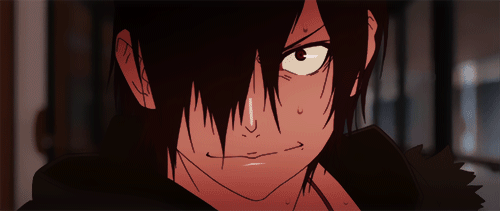
5. We have outlived you Little foot.
Octopus were existent since the Carboniferous making them waaaaay older than dinosaurs and date back a whopping 296 million years.
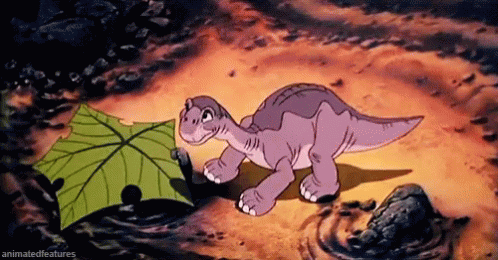
6. Colorblind but not really
While the eyes of octopus suggested a convergent evolution with those of humans in terms of their structural parts, they are colorblind. They have only one type of receptor which makes them incapable of colored vision but it is their bizarre shaped eyes that allows light to enter in may directions, creating blurred images - an effect called chromatic aberration.
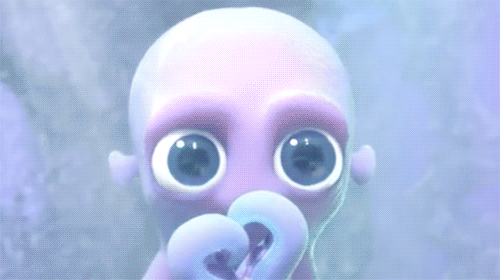
7. Hey, daydreamer!
Experiments on octopuses have revealed that they are able to change their camouflage during sleep. Whether they were dreaming or not is still a mystery to a lot of scientists.

And that’s all about Octopie and some of her friends.
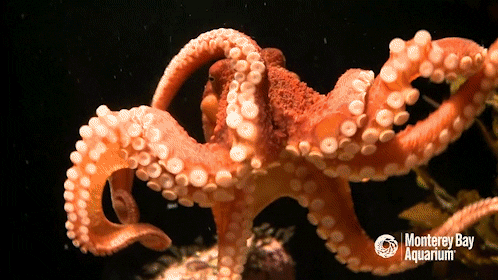
Ugh finally, Octopie is now back to her home!
References
Bradford, A. (2017). Octopus Facts. Live Science. Retrieved 2020 October 6 from:https://www.livescience.com/55478-octopus-facts.html#:~:text=The%20common%20octopus%20(Octopus%20vulgaris,and%20weight%20around%20110%20lbs.
Case, R. (1999). "Octopus vulgaris". Animal Diversity Web. Retrieved 2020 October 5 from:https://animaldiversity.org/accounts/Octopus_vulgaris/
ITIS (Integrated Taxonomic Information System). (2020). Octopus vulgaris (Cuvier 1797). Retrieved 2020 October 6 from:https://www.itis.gov/servlet/SingleRpt/SingleRpt?search_topic=TSN&search_value=82603#null
MarineBio. (c1998-2020). Common Octopuses, Octopus vulgaris. Retrieved 2020 October 6 from ,for%20up%20to%201.5%20years.
Notord. (2017). Octopus: The Cursed Genius of the Ocean. Retrieved 2020 October 10 from: https://steemit.com/science/@natord/octopus-the-cursed-genius-of-the-ocean
WordPress. (2014). Anatomy. Retrieved 2020 October 6 from :https://cephalopods2014.wordpress.com/anatomy/
Seafood Tip. (2020). Octopus in the Philippines. Retrieved 2020 October 6 from https://seafood-tip.com/sourcing-intelligence/countries/philippines/octopus/
Octopus Anatomy Diagram, (n.d.). [image]. Anatomy Note Web site. Retrieved 202 October 6 from https://www.anatomynote.com/animal-anatomy/marine-animal-anatomy/octopus/octopus-anatomy-diagram/
Su-Lin. (2018). Takeaway takoyaki. [image]. Flickr Web site. Retrieved 2020 October 6 from https://www.flickr.com/photos/15157510@N00/2308993346
Saelinger, T. (2013). Octopus carpaccio. [image]. Today Web site. Retrieved 202 October 6 from https://www.today.com/food/abundance-octopus-inspires-chefs-get-creative-6C10185385
Saelinger, T. (2013). Fideo with octopus and kielbasa. [image]. Today Web site. Retrieved 2020 October 6 from https://www.today.com/food/abundance-octopus-inspires-chefs-get-creative-6C10185385
Saelinger, T. (2013). Charred octopus. [image]. Today Web site. Retrieved 2020 October 6 from https://www.today.com/food/abundance-octopus-inspires-chefs-get-creative-6C10185385
Octopus. (2019). [image]. Vietnam News Web site. Retrieved 2020 October 6 from https://vietnamnews.vn/economy/484737/s-korea-largest-export-market-for-vietnamese-squid-and-octopus.html
Steene, R. (2013). Octopus hiding in a coconut shell. [image]. Live Science Web site. Retrieved 2020 October 6 from https://www.livescience.com/41924-smart-octopus-facts.html
Octopus hiding in a shell. (2019). [image]. Thoughtco Web site. Retrieved 2020 October 6 from https://www.thoughtco.com/fascinating-octopus-facts-4064726#:~:text=If%20the%20invertebrate%20structure%20has%20suckers%20along%20its,cuttlefishand%20squids%2C%20have%20eight%20arms%20and%20two%20tentacles.
4 notes
·
View notes